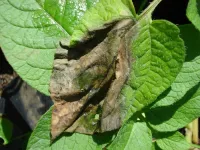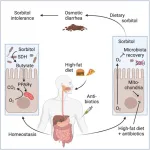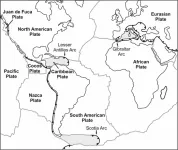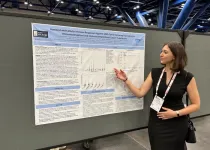Using written records – and tweets – as a roadmap for plant disease spread
2024-02-15
(Press-News.org) North Carolina State University researchers used text analytics on both historic and modern writing to reveal more information about the effects and spread of the plant pathogen – now known as Phytophthora infestans – that caused the 1840s Irish potato famine and that continues to vex breeders of potatoes and tomatoes.
The study examined keyword terms like “potato rot” and “potato disease” after digitizing historic farm reports, news accounts and U.S. Patent Office agricultural records from 1843 to 1845 to show how the pathogen first spread across the northeast United States before causing the devastating famine in Ireland in 1845. The study also used text analysis to track social media feeds for the modern-day spread of late blight.
Textual analysis holds promise as a useful tool to help researchers track and visualize both historic and current plant diseases, the researchers say.
“We went back to original descriptions of the potato disease outbreaks in the United States because they occurred between 1843 and 1845, before outbreaks occurred in Europe,” says Jean Ristaino, William Neal Reynolds Distinguished Professor of Plant Pathology at North Carolina State University and corresponding author of a paper in Scientific Reports that describes the study. “We searched those descriptions by keywords, and by doing that we were able to recreate the original outbreak maps using location coordinates mentioned in the documents.
“We were also trying to learn what people were thinking about the disease at the time and where it came from.”
The analysis documents late blight disease on potatoes in five states – New York, Delaware, Massachusetts, New Jersey and Pennsylvania – before it spread to the rest of the northeastern U.S. and into Canada between 1843 and 1845. The pathogen later wreaked havoc on Europe – especially Ireland.
The paper also examined tweets from 2012 to 2022 to learn more about modern spread of P. infestans. They mined tweets for both common and scientific names of the pathogen and were able to geolocate the sources.
“The social media mining was interesting because we found that most people talking about this disease are scientists in developed countries promoting their own work on Twitter (now X),” Ristaino said. “It was also interesting to note that states where the disease appeared all those many years ago still have the disease now.”
The study also used Google Ngram search terms to reveal a surprising finding. The researchers saw a spike in late blight disease reported in 1950s documents. Drilling down into the relevant academic literature cited in the documents, Ristaino saw evidence of a large late blight outbreak in tomatoes in the United States after World War II.
“That could have been the emergence of a new North American strain of the pathogen, known as U.S. 1, that became really widespread after that,” Ristaino said.
Ristaino added that she and her team plan to continue this type of work and expand the analytic tools to other plant diseases and pests.
Co-authors Ariel Saffer, Laura Tateosian and Yi-Peng Yang are part of NC State’s Center for Geospatial Analytics. Amanda C. Saville, a research specialist in Ristaino’s lab, also co-authored the paper. Funding was provided by the Triangle Center for Evolutionary Medicine Seed Grant; the U.S. Dept. of Agriculture’s NIFA under grant number 2015-2370; and by the National Science Foundation PIPP Phase 1 grant number 2022-1191.
-kulikowski-
Note to editors: The abstract of the paper follows.
“Reconstructing Historic and Modern Potato Late Blight Outbreaks Using Text Analytics”
Authors: Ariel Saffer, Laura Tateosian, Amanda C. Saville, Yi-Peng Yang and Jean B Ristaino, NC State University
Published: Feb. 15, 2024 in Scientific Reports
DOI:
Abstract: In 1843, a hitherto unknown plant pathogen entered the U.S. and spread to potato fields in the northeast. By 1845, the pathogen had reached Ireland leading to devastating famine. Questions arose immediately about the source of the outbreaks and how the disease should be managed. The pathogen, now known as Phytophthora infestans, still continues to threaten food security globally. A wealth of untapped knowledge exists in both archival and modern documents, but is not readily available because the details are hidden in descriptive text. We 1) used text analytics of unstructured historical reports (1843-1845) to map U.S. late blight outbreaks; 2) characterized theories on the source of the pathogen and remedies for control; and 3) created modern late blight intensity maps using Twitter feeds. The disease spread from 5 to 17 states and provinces in the U.S. and Canada between 1843-45. Crop losses, Andean sources of the pathogen, possible causes and potential treatments were discussed. Modern disease discussion on Twitter included near-global coverage and local disease observations. Topic modeling revealed general disease information, published research, and outbreak locations. The tools described will help researchers explore and map unstructured text to track and visualize pandemics.
END
[Attachments] See images for this press release:

ELSE PRESS RELEASES FROM THIS DATE:
2024-02-15
Large national study finds that video visits, texting and mailing pills are all effective, as the U.S. Supreme Court considers limiting access to telemedicine abortion.
Medication abortion can be delivered safely and effectively through telemedicine, according to new research from UC San Francisco that comes as the U.S. Supreme Court is about to hear a case that could severely restrict access to one of the two pills that are used to induce abortions.
Researchers analyzed data from more than 6,000 patients who obtained abortion ...
2024-02-15
(SACRAMENTO, Calif.) — Researchers at UC Davis have identified changes in the gut microbiome that can result in an inability to digest sorbitol.
Sorbitol, a sugar alcohol, is used in sugar-free gum, mints, candy and other products. It is also found naturally in apricots, apples, pears, avocadoes and other foods. At high levels, sorbitol can cause bloating, cramps and diarrhea. For some people, even a small amount causes digestive upset, a condition known as sorbitol intolerance.
A new study with mice found that taking antibiotics, combined with a high-fat diet, reduced the number of Clostridia gut microbes, which can break down sorbitol. ...
2024-02-15
With age, cells can experience senescence, a state where they stop growing but continue releasing inflammatory and tissue-degrading molecules. When a person is young, the immune system responds and eliminates senescent cells, often referred to as zombie cells. However, zombie cells linger and contribute to various age-related health problems and diseases. Mayo Clinic researchers, in two studies, shed light on the biology of aging cells.
In a study published in Aging Cell, Mayo Clinic researchers analyzed zombie ...
2024-02-15
Contributed by Arianna Soldati, GSA Science Communication Fellow
Our planet’s lithosphere is broken into several tectonic plates. Their configuration is ever-shifting, as supercontinents are assembled and broken up, and oceans form, grow, and then start to close in what is known as the Wilson cycle.
In the Wilson cycle, when a supercontinent like Pangea is broken up, an interior ocean is formed. In the case of Pangea, the interior ocean is the Atlantic. This ocean has a rift in the middle, and passive margins on the side, which means no seismic or volcanic activity occurs along its shores. Destined to keep expanding, an Atlantic-type ...
2024-02-15
When an enemy invades, defenders are ferried to the site to neutralise the marauders. In the human body, a protein carrier called SPNS2 transports S1P molecules from endothelial cells to rally immune cell response in infected organs and tissues.
Using specially-developed nanobodies that bind to SPNS2 and enlarge the entire structure, the enlarged SPNS2 structure allows the S1P molecules to be viewed via cryogenic electron microscopy. Scientists from the Immunology Translational Research Programme at the Yong Loo Lin School of Medicine, ...
2024-02-15
WASHINGTON, February 15, 2024—The American Educational Research Association (AERA) has announced the selection of 24 exemplary scholars as 2024 AERA Fellows. The AERA Fellows Program honors scholars for their exceptional contributions to, and excellence in, education research. Nominated by their peers, the 2024 Fellows were selected by the Fellows Committee and approved by the AERA Council, the association’s elected governing body. They will be inducted during a ceremony at the 2024 Annual Meeting in Philadelphia on April 12. With this cohort, there will be a total of 762 AERA ...
2024-02-15
First-year Hackensack Meridian School of Medicine (HMSOM) student Elizabeth Titova leveraged her background in phlebotomy and scientific research to publish a new clinical study around COVID-19 vaccination in Microbiology Spectrum, a peer-reviewed, open-access ASM Journal.
In her study, Titova found that while naturally stronger in immunocompetent individuals, the immunocompromised population—”especially cancer patients undergoing treatment”—still received a “robust immune response” from the vaccine, indicating protection against SARS-CoV-2.
This ...
2024-02-15
It is not uncommon for people to “hit the wall” at work and experience burnout for short or long periods of time.
“We have found that approximately 13 per cent of Norwegian employees are at high risk of burnout,” says Leon De Beer, Associate Professor of Work and Organizational Psychology at the Norwegian University of Science and Technology (NTNU) Department of Psychology.
De Beer has contributed to a new study on burnout published in the Scandinavian Journal of Psychology with colleagues from the Healthy Workplaces research group.
They are working on a new tool that can identify people at risk of burnout. ...
2024-02-15
Women with HIV experience accelerated DNA aging, a phenomenon that can lead to poor physical function, according to a study led by Stephanie Shiau, an assistant professor in the Department of Biostatistics and Epidemiology at the Rutgers School of Public Health.
Published in The Journal of Infectious Diseases, the study sheds light on the unique challenges faced by women with HIV as they age and opens avenues for tailored interventions to enhance health outcomes. Globally, over 50 percent of individuals living with HIV are ...
2024-02-15
Parents of young children with an excitable or exuberant temperament could adapt their parenting style to help moderate their child’s potential development of Attention Deficit/Hyperactivity Disorder (ADHD), according to a new study co-authored by a University of Waterloo researcher.
Developmental psychologists know that temperament, parenting, and the brain’s executive functions are interconnected factors in developing ADHD symptoms throughout childhood. But, the study found specific factors that predict a higher chance of ADHD symptoms, pointing to the importance ...
LAST 30 PRESS RELEASES:
[Press-News.org] Using written records – and tweets – as a roadmap for plant disease spread




